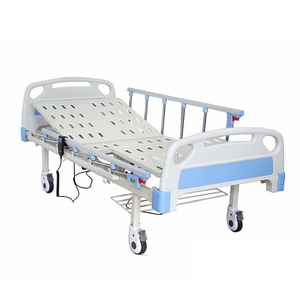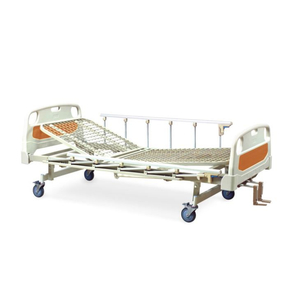When considering the purchase or distribution of hospital equipment, one of the most important factors to evaluate is the weight of the hospital bed. For manufacturers, distributors, and factory operators, understanding the weight of a hospital bed can significantly impact logistics, transportation, and overall operational efficiency. In this research paper, we will delve into the various factors that influence the weight of a hospital bed, including materials, design, and functionality. Additionally, we will explore the implications of bed weight on shipping, handling, and installation, as well as its impact on patient care and safety.
To provide a comprehensive understanding, we will reference data from industry leaders like TopMedi, a prominent supplier of hospital beds and medical equipment. This analysis will also consider the weight ranges of different types of hospital beds, including manual and electric models, and how these variations affect the decision-making process for factories, distributors, and resellers.
By the end of this paper, you will have a clearer understanding of how much a hospital bed weighs, the factors that contribute to its weight, and the implications for your business. Whether you are a manufacturer, distributor, or reseller, this knowledge will help you make informed decisions about the products you handle and the logistics involved.
Factors Influencing the Weight of a Hospital Bed
1. Material Composition
The materials used in constructing a hospital bed play a significant role in determining its weight. Most hospital beds are made from a combination of metals, plastics, and sometimes wood. The most common metals used are steel and aluminum, each contributing differently to the overall weight.
Steel: Known for its strength and durability, steel is a common material in hospital beds, especially in the frame. However, it is also heavier than other materials, which increases the bed's total weight.
Aluminum: Lighter than steel, aluminum is often used in modern hospital beds to reduce weight while maintaining strength. It is especially common in electric hospital beds where mobility and adjustability are key.
Plastic Components: Plastic is often used for non-structural parts such as side rails, headboards, and footboards. While plastic is lightweight, its use is limited to areas that do not require significant strength.
The choice of materials can vary based on the type of hospital bed. For example, electric hospital beds tend to use more aluminum to keep the bed lightweight and easy to adjust, while manual beds may rely more on steel for durability.
2. Bed Size and Design
The size and design of a hospital bed also contribute to its weight. Standard hospital beds typically measure around 36 inches in width and 80 inches in length, but bariatric beds, designed for larger patients, can be much wider and longer. The larger the bed, the more material is required, which increases the overall weight.
In addition to size, the design of the bed—whether it is a manual, semi-electric, or fully electric model—affects its weight. Electric beds, for instance, require motors and additional components for adjustability, which add to the bed's weight. On the other hand, manual beds, which rely on mechanical cranks, tend to be lighter but require more physical effort to operate.
3. Functionality and Features
Hospital beds come with various features that can impact their weight. Beds with advanced functionalities, such as multiple adjustment points, built-in scales, or integrated electronic systems, tend to weigh more due to the additional components. For example, a bed with a five-function electric system will weigh more than a basic manual bed with two functions.
The inclusion of accessories like side rails, IV poles, and overbed tables can also increase the weight of the bed. While these features enhance the bed's usability and patient comfort, they add to the overall mass that needs to be considered during transportation and installation.
Weight Ranges of Different Hospital Beds
1. Manual Hospital Beds
Manual hospital beds are typically the lightest option, as they do not include motors or electronic components. These beds generally weigh between 150 and 250 pounds, depending on the materials used and the bed's size. For example, a manual hospital bed from TopMedi may weigh closer to the lower end of this range due to its use of lightweight materials like aluminum.
2. Semi-Electric Hospital Beds
Semi-electric hospital beds offer a middle ground between manual and fully electric models. These beds typically feature motorized adjustments for the head and foot sections but require manual operation for height adjustments. As a result, semi-electric beds weigh more than manual beds, typically ranging from 200 to 300 pounds.
The added weight comes from the motors and electrical components, which increase the bed's functionality but also add to the logistical considerations for transportation and installation.
3. Fully Electric Hospital Beds
Fully electric hospital beds are the heaviest option, as they include motors for all adjustment points, including height, head, and foot sections. These beds can weigh anywhere from 250 to 400 pounds, depending on the features and materials used. For example, a fully electric bed with a five-function system, such as the one offered by TopMedi, will be on the higher end of this range due to its advanced functionality.
While fully electric beds offer the most convenience and ease of use, their weight can pose challenges for transportation and installation, especially in facilities with limited space or access.
Impact of Hospital Bed Weight on Logistics and Operations
1. Shipping and Transportation
The weight of a hospital bed directly affects shipping costs and transportation logistics. Heavier beds require more robust packaging and handling, which can increase shipping expenses. Additionally, the weight of the bed may limit the number of units that can be transported in a single shipment, affecting overall efficiency.
For distributors and resellers, understanding the weight of the beds they handle is crucial for optimizing shipping costs and ensuring timely delivery. For example, when ordering from a supplier like TopMedi, it is essential to factor in the weight of the beds to calculate accurate shipping costs and delivery times.
2. Installation and Handling
Heavier hospital beds require more manpower and equipment for installation. In facilities with limited access or space, moving and setting up a heavy bed can be challenging. Additionally, the weight of the bed may necessitate the use of specialized equipment, such as lifts or dollies, to ensure safe handling during installation.
For factory operators and distributors, understanding the weight of the beds they handle can help them plan for the necessary resources and equipment needed for installation. This is especially important for large-scale installations, where multiple beds need to be set up in a short period.
In conclusion, the weight of a hospital bed is influenced by several factors, including material composition, size, design, and functionality. Understanding these factors is crucial for manufacturers, distributors, and resellers, as the weight of the bed affects shipping, transportation, installation, and overall operational efficiency.
For those in the hospital bed industry, it is essential to consider the weight of the beds they handle and how it impacts their business. By working with reliable suppliers like TopMedi, you can ensure that you are getting high-quality products that meet your needs while optimizing logistics and operational efficiency.
Whether you are dealing with manual, semi-electric, or fully electric beds, understanding the weight of the bed is key to making informed decisions about your inventory, shipping, and installation processes. With this knowledge, you can better serve your customers and improve the overall efficiency of your operations.





















